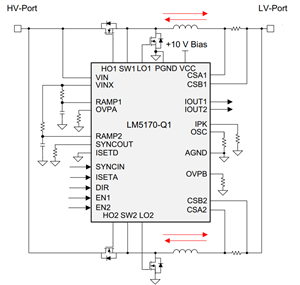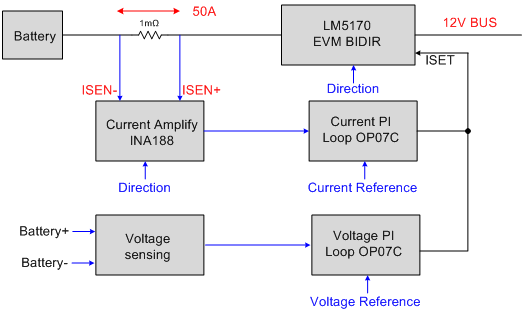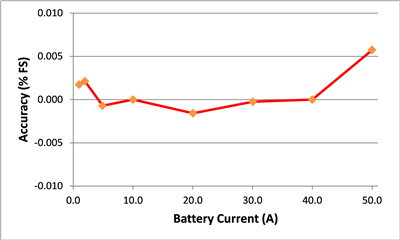SSZT745 april 2018 INA188 , LM5170-Q1 , OP07C
A battery test system (BTS) offers high voltage and current control accuracy to charge and discharge a battery. It is mainly used in manufacturing during production of the battery. Battery test equipment can also be used in R&D departments to study battery performance.
One typical application of a BTS is to charge and discharge a one-cell lithium-ion battery. Considering the voltage drop in the cable, the voltage required to do this is 0V to 5V. When the battery is charging, the power bus voltage is typically 12V in order to obtain good efficiency in voltage conversion. The bus voltage increases to 14V when the battery energy discharges back to the power bus. So the BTS requires a bidirectional converter that supports a 12V-to-14V input voltage and a 0V-to-5V output voltage. The converter operates in buck mode when charging the battery and in boost mode when discharging the battery.
The LM5170-Q1 bidirectional current controller is a good fit for this application. This device regulates the average current flowing between the high-voltage (HV) and low-voltage (LV) port in the direction designated by a DIR pin. Figure 1 is a simplified schematic of the LM5170-Q1. The two phases’ interleave topology offers up to 100A of charge or discharge current. Its integrated 5A driver helps optimize efficiency in voltage conversion, which means small power loss and good thermal performance for the system. The diode-emulation feature of the LM5170-Q1 prevents current from flowing opposite from the direction selected by the DIR pin. This feature helps protect the battery from overcharge or discharge during transient periods.
 Figure 1 LM5170-Q1 Simplified
Schematic
Figure 1 LM5170-Q1 Simplified
SchematicOne critical requirement of the BTS is the current accuracy, which should be better than 0.05% of full scale. Because the LM5170-Q1 integrated current amplifier can’t meet this requirement, an external current-sensing resistor and amplifier are required to improve the current accuracy.
To demonstrate the feasibility of the LM5170-Q1 in achieving this current accuracy, TI released the 50A, 0.05% Current Accuracy Power Reference Design for Battery Test Systems to target applications that charge or discharge one-cell lithium-ion batteries with high current accuracy.
Figure 2 is a block diagram of the reference design. The lithium-ion is connected to the LV port of the LM5170EVM through a 1mΩ resistor. The HV port is connected to the 12V-14V bus. The current through the battery is sensed by the voltage drop of the 1mΩ resistor using the INA188. The output of INA188 feeds into the OP07C operational amplifier, which generates an integrating signal using the difference between the output of the INA188 and the reference voltage. The reference voltage is provided by a microcontroller not included in this reference design.
The output of the OP07C connects to the ISETA pin of the LM5170-Q1, which regulates the current flowing through the 1mΩ resistor to the current reference. The battery voltage is also sensed and regulated based on the voltage reference. When the battery voltage doesn’t reach the voltage reference, the battery current is controlled at the current reference. When the battery does reach the voltage reference, the voltage loop overrides the current loop and the battery current increases to zero. The direction of the current to charge or discharge the battery is controlled by a logic signal (indicated as “Direction” in Figure 2). This logic signal is connected to the DIR pin of the LM5170-Q1. It also controls the INA188 input signal direction through analog multiplexers.
 Figure 2 50A, 0.05% Current Accuracy
Power Reference Design for Battery Test Systems Block Diagram
Figure 2 50A, 0.05% Current Accuracy
Power Reference Design for Battery Test Systems Block DiagramFigure 3 shows the current accuracy when charging the battery from 1A to 50A. The test data shows that the current accuracy is much better than 0.05%, which proves the capability of the LM5170-Q1 in a BTS application.
 Figure 3 Battery Charging Current
Accuracy
Figure 3 Battery Charging Current
AccuracyTable 1 shows the output voltage at different reference voltage conditions, with the voltage gap less than 0.5mV from a 0.05V-5V reference voltage, which is also good for BTS applications.
| Reference voltage (V) | 0.04968 | 0.4988 | 0.99788 | 1.99434 | 2.9912 | 3.98935 | 4.98531 |
| Actual voltage (V) | 0.04969 | 0.49882 | 0.99788 | 1.99433 | 2.99116 | 3.98935 | 4.98526 |
The LM5170-Q1 is a good fit for applications that require an energy exchange between two power sources. Its high driver current, diode emulation and cycle-by-cycle peak-current limit features greatly improve efficiency in voltage conversion and also provide good protection during stable and transient periods. Get more information on TI’s products for battery test equipment.